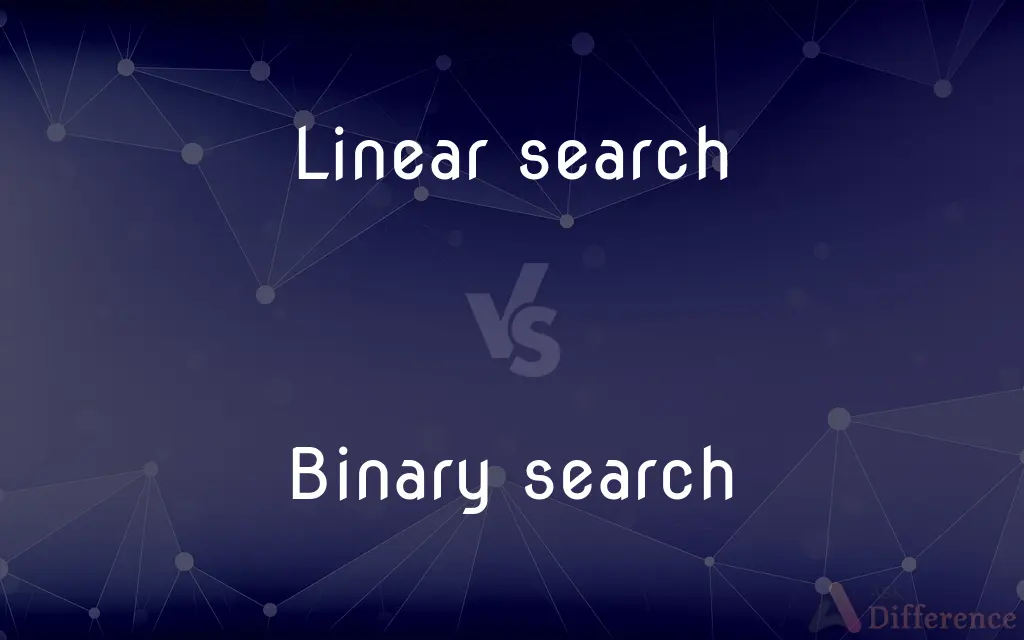Linear search vs. Binary search — What's the Difference?
By Tayyaba Rehman — Published on January 14, 2024
Linear search sequentially checks each element of a list to find a match. Binary search repeatedly divides a sorted list in half to locate an item efficiently.

Difference Between Linear search and Binary search
Table of Contents
ADVERTISEMENT
Key Differences
Linear search, also known as sequential search, is a simple method where each element in a list is checked in order until the desired element is found or the list ends. It does not require the list to be sorted. Binary search is more complex and efficient, requiring a sorted list. It works by dividing the search interval in half repeatedly until the target value is found.
Linear search is straightforward and does not require any preparation of the data, making it suitable for unsorted lists. It’s easy to implement but becomes inefficient as the size of the list increases. Binary search, in contrast, is highly efficient for large, sorted lists as it significantly reduces the number of comparisons needed to find an element.
The time complexity of a linear search is O(n), meaning the time to search increases linearly with the number of elements. Binary search has a time complexity of O(log n), making it much faster for large datasets. However, the list must be sorted initially, which can incur an additional cost if the data isn't already sorted.
Linear search can be used on any list, regardless of whether the data is structured or unsorted. This makes it versatile but not always the most time-efficient. Binary search is ideal when dealing with large, sorted datasets, such as database records or large arrays, where quick searches are required.
In summary, linear search is simple and universal but less efficient for larger datasets. Binary search is an efficient alternative but requires a sorted list and is more complex to implement.
ADVERTISEMENT
Comparison Chart
Data Requirements
Works on unsorted or sorted lists.
Requires a sorted list.
Method of Search
Sequentially checks each element.
Divides the list in half repeatedly.
Time Complexity
O(n) - efficiency decreases as list size increases.
O(log n) - more efficient for larger lists.
Implementation Complexity
Simple to implement.
More complex to implement.
Best Use Case
Small lists or unsorted data.
Large, sorted datasets.
Compare with Definitions
Linear search
Checks each element in a list sequentially.
Used linear search to find the book's ISBN in an unsorted list.
Binary search
Ideal for large datasets where data is sorted.
Binary search was employed for efficient retrieval in the sorted archive.
Linear search
Time efficiency decreases with larger lists.
The linear search took longer as the number of entries grew.
Binary search
Divides the search interval in half iteratively.
Binary search quickly located the item in the sorted array.
Linear search
Simple and easy to implement.
Implemented a linear search algorithm for the small dataset.
Binary search
Requires a pre-sorted list to operate.
Sorted the database first to apply binary search effectively.
Linear search
Does not require sorting of the list.
Linear search was the go-to method due to the list's random order.
Binary search
More efficient than linear search for large lists.
Used binary search to handle the large, sorted customer list.
Linear search
Universally applicable but less efficient for large data.
Opted for linear search in the absence of sorted data.
Binary search
Has a logarithmic time complexity.
Binary search improved the search time significantly in the large dataset.
Common Curiosities
What is linear search used for?
For searching elements in small or unsorted lists.
Can binary search be used on unsorted lists?
No, it requires the list to be sorted.
What is binary search best suited for?
Quick searching in large, sorted datasets.
Is binary search faster than linear search?
Yes, especially in large, sorted lists.
Does linear search work on unsorted data?
Yes, it’s effective regardless of data order.
What happens if you apply binary search on an unsorted list?
It will not reliably find the element, leading to incorrect results.
What is the main drawback of binary search?
It cannot be used without sorting the data first.
How does binary search reduce search time?
By halving the search space with each iteration.
Is linear search easy to code?
Yes, it’s one of the simplest search algorithms.
How does the size of data affect linear search?
Efficiency decreases as the size increases.
Can binary search be used in databases?
Yes, particularly in sorted database indexes.
Why is linear search not preferred for large datasets?
Due to its linear increase in search time with data size.
Can binary search be applied to linked lists?
It's less efficient on linked lists due to sequential access.
Can linear search be optimized for better performance?
Its fundamental approach limits optimization potential.
Is binary search suitable for real-time applications?
Yes, if the data is sorted and search speed is critical.
Share Your Discovery

Previous Comparison
Inductive Research vs. Deductive Research
Next Comparison
Acetic Acid vs. Glacial Acetic AcidAuthor Spotlight
Written by
Tayyaba RehmanTayyaba Rehman is a distinguished writer, currently serving as a primary contributor to askdifference.com. As a researcher in semantics and etymology, Tayyaba's passion for the complexity of languages and their distinctions has found a perfect home on the platform. Tayyaba delves into the intricacies of language, distinguishing between commonly confused words and phrases, thereby providing clarity for readers worldwide.
















































